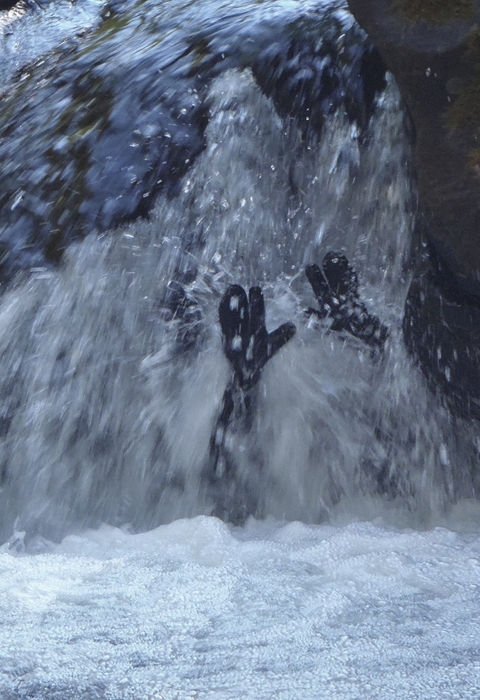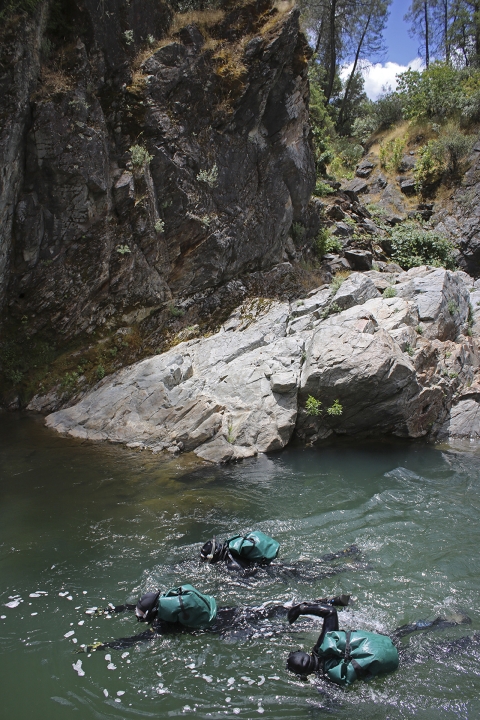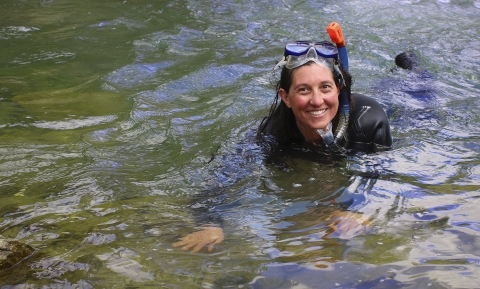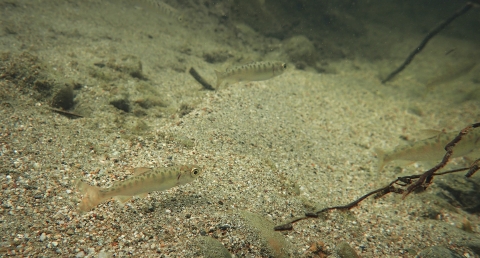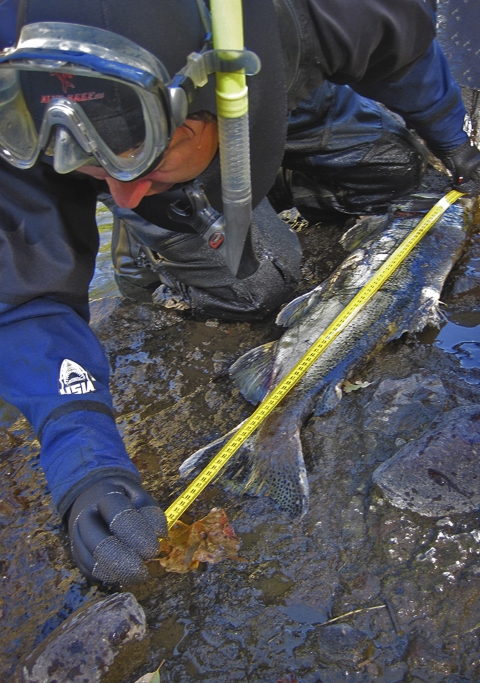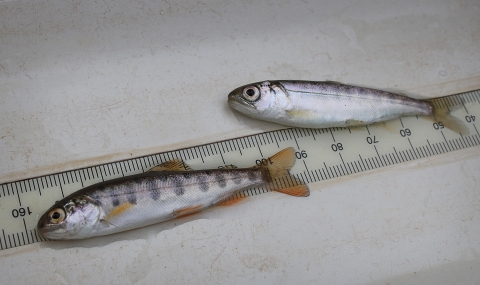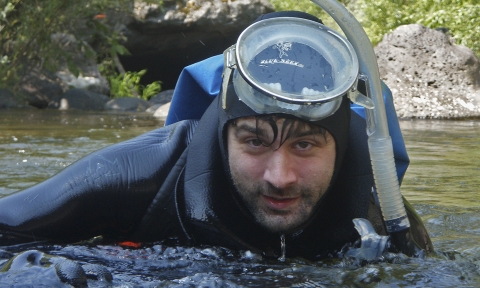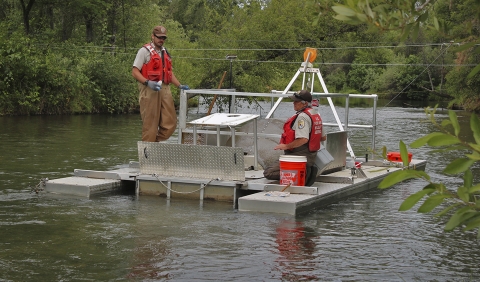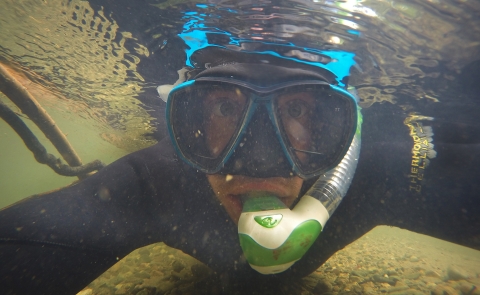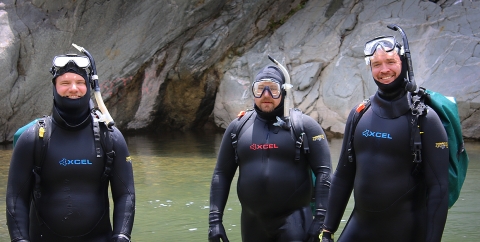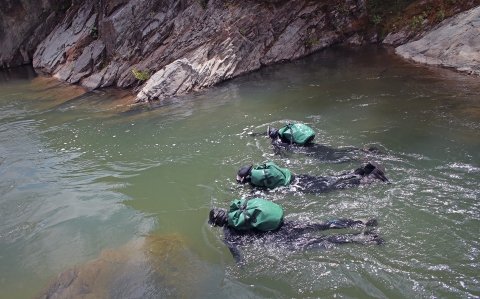Snorkeling for a living may sound like a lot of fun, but when it comes to Chinook salmon survey counts for the U.S. Fish and Wildlife Service’s Red Bluff office, the work is actually quite demanding yet very important for persistence of the species and restoration of their habitats.
"I definitely must stress that these surveys kick your butt, so I want to give props to the field crew," said R.J. Bottaro, supervisory fish biologist for the Red Bluff Fish and Wildlife Office, who worked the snorkel survey counts on Clear Creek and Battle Creek for 10 years. "It’s every week so eventually you get bruises on your hips because you are hitting rocks. Your arms are all beaten up because you are swimming face first in the stream and you are coming up on rocks with sometimes poor visibility. You get moving pretty fast depending on how high the water is, and the variability of different flows can create a challenge."
The snorkelers must be in great physical condition and are all swift water trained which means they must be able to rescue themselves and others in serious situations.
"I’ve had to help someone once who got their foot hooked into a rock when swimming downstream," said Bottaro. "They were trying to maneuver around a waterfall, and just as the person’s head went under from the foot entrapment, I was able to hold them above until someone else was able to come over and get his foot out. It’s something that happens at 8:30 in the morning and wakes you all up."
"It is thrilling, exciting and challenging with the rapids," said Sarah Gallagher, supervisory fish biologist for the Red Bluff Fish and Wildlife Office. "Water is not to be taken lightly. You can be comfortable in the water but I think there are a lot of dangers out there so you have to be very careful about what you are doing, very aware with your crew. You can take hits with rocks."
In addition to the physical challenges, Chinook salmon snorkel survey biologists must be able to count the fish quickly. The information from the snorkel surveys is important for evaluating the different salmon populations including adult spring run and steelhead which are threatened species under the Endangered Species Act. The biologists also evaluate habitat quality for juvenile salmon, especially after restoration work is done on the stream.
"We’re fish counting machines," said Gallagher, who has 17 years of experience on Clear Creek. "We swim through using high-grade GPS units to record locations of live fish, redds and carcasses.
"Snorkeling is a real connection for me to the river. I’ve wanted to be a fish biologist since I was little. I grew up on Lake Ontario, so working on flowing water was a new experience for me when I started my career. The snorkeling is really informing what kind of habitat salmonids are using and if we are creating the right type of habitat in the future."
"Snorkeling is so peaceful and the beauty under the water is something to behold," said Travis Webster, fisheries biologist with the Service. "This is a dream job. What we are doing out here is so important to the management of the species."
Matt Brown, a fish biologist and 22-year employee of the Red Bluff office, agreed. "I think that data gathered for Clear Creek restoration is really important to the public because one of the best and last places to restore salmon is in the Central Valley," said Brown. "Clear Creek is an example that shows people that there’s hope and promise to the restoration work."
Management decisions that include requests to increase water flows, add gravel to improve spawning habitat and manipulate the channel to improve juvenile salmonid rearing can be made based on data from the snorkel surveys.
These decisions require information about where fish are and when they are there.
"This work benefits not only the number of fish, but also the economies that depend on the fish," said Brown. "This also helps out the wider Central Valley and the state in that Clear Creek salmon, especially the fall run, are caught by fisherman in the ocean and Sacramento River. This improved catch not only provides a great recreational experience but provide a large economic benefit to the depressed economies of coastal California and Sacramento River communities."
Part of the job involves finding carcasses of the adult Chinook salmon after they spawn. The carcasses provide biological data such as genetics, age, size of the fish, how fast they grew, when the salmon run is coming and going, and the overall health.
"They can be pretty gnarly too," said Bottaro of the job of picking up the carcasses. "You are out there swimming and these things have been sitting out there for a couple of weeks, and so they are full of puss, maggots and nasty stuff and you get it all over you."
Bottaro recalled a time when his colleague Gallagher swam around a corner into more than 70 rotting carcasses. That’s why there is not a typical day or amount of time spent in the water for snorkelers. "It can vary between a quick three hours up to 12," he said.
The Service also is involved in important restoration work to help the species at various stages of life.
Fish passage is the ability of fish or other aquatic species to move freely throughout their life to find food, reproduce, and complete their natural migration cycles. Millions of barriers to fish passage across the country are fragmenting habitat and leading to species declines. The U.S. Fish and Wildlife Service's National Fish Passage Program is working to reconnect watersheds to benefit both wildlife and people.
Learn more about fish passage barriers where the fish cannot make it upstream to hold and spawn," said biologist R.J. Bottaro. "You wouldn’t know it unless you went out there." Photo courtesy of R.J. Bottaro/USFWS
"What we are doing with snorkel surveys is evaluating the salmon populations including adult spring run (trying to find out what the population is and where they hold and spawn) and looking at juvenile habitat in relation to restoration work such as reconstructing the channel, before and after," said Gallagher. "So we use the snorkel observations to see what kind of habitat the juveniles (Chinook salmon and steelhead) are using."
This helps the Service and its partners continue to improve their stream restoration efforts.
The restoration involves multiple processes. Since the Chinook salmon need water temperatures below 60 degrees, and even colder for spawning, the Service at times will work with the Bureau of Reclamation to manipulate the creek's flows and decrease temperature. The Service also works with a number of partners to restore parts of the creek to a more natural state.
Finally, with sediment being held back by a large dam in Clear Creek for example, adding various types of gravel is necessary to provide spawning habitat.
The Service also uses large metal cone-shaped screw traps being used to capture and later measure juveniles. This, along with snorkel surveys offers the biologists the ability to monitor the entire life cycle of Chinook salmon.
"There are some places where there are fish passage barriers where the fish cannot make it upstream to hold and spawn," said Bottaro. "You wouldn’t know it unless you went out there (snorkeling) and saw where the redds were and where the fish were holding."
Management decisions to include requests to increase water flows can be made based on data from the snorkel surveys.
"It is pretty widely acknowledged by the salmon restoration community that this is a really successful project," said Brown of the progress made towards restoration of Clear Creek. "It has been a consistent program for over 20 years at providing fish improved habitat and doing restoration in a cost-effective way. Observing salmon behavior by snorkeling is important so people understand what the restored habitat is doing and track it over time.
"You want natural processes moving water, gravel, reshaping the environment – that is really important for the fish. If you don’t watch how that is happening it could go in the wrong direction," he added.
Gallagher concluded: "Natural spaces provide an intrinsic value that we need to survive in this world. Science helps us to understand what is going on, and how we can take actions to make it better."
Clear Creek: A watershed tranformed
One of the first streams the 49ers came to looking for gold, Clear Creek has always been a natural attraction. The miners started with hand tools, moved to sluices and water cannons, and finished with a giant dredge that moved the entire streambed onto the banks. In the 1960’s, the Whiskeytown reservoir was built.
For more than 20 years, the U.S. Fish and Wildlife Service, California Department of Fish and Wildlife, Bureau of Reclamation, Bureau of Land Management, National Marine Fisheries Service and Western Shasta Resource Conservation District have been working to restore Clear Creek to improve habitat and recover populations of Central Valley spring run, fall run and late-fall run Chinook salmon and Central Valley steelhead.
Today, you can enjoy hiking, mountain biking, swimming, fishing and salmon viewing along Clear Creek by visiting Clear Creek Greenway, located just a few miles southwest of Redding, California.
There are numerous trailheads that allow access to the creek and non-motorized trails in the area. From Highway 273, head west on Clear Creek Road. The Clear Creek Gorge Overlook is located four miles out Clear Creek Road on the left.
